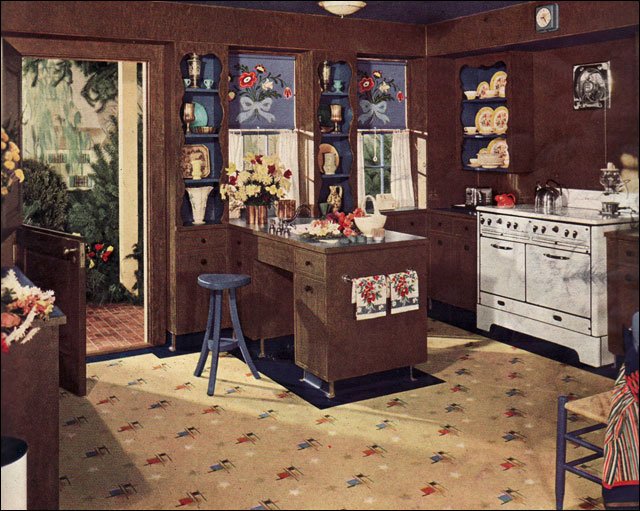Amazing vintage photos show what kitchens looked like between the 1940s and 1950s

By the early 1900s, household electricity and running water began to become a norm in the Western world. Industrialization brought the development of kitchen design to a new era.
Mass-produced fixtures, sometimes modern appliances, cabinetry, lighting, and storage units, and gas stoves were introduced in factories.
But it wasn't until the 1930s that the kitchen began to take on its modern shape. The kitchen configuration we all know now has its roots, like a lot of modern design, in the German school known as the Bauhaus.
For the Bauhaus designers, there was nothing to add beauty to a functional item as extra frills; Instead, it was achieved through careful choices of materials, proportions, textures and colors for the functional characteristics of the objects.
Wall-mounted cabinets are built on a continuous countertop resting on more built-in cabinets between the sink and cooker.
In addition to simple projecting knobs, the faces of the cabinets are flush and smooth; There are no moldings, panels or decorative elements that will collect dirt. The entire floors are rubber, with a linoleum option so that all surfaces are easy to clean with a quick wipe down.

An Austrian architect, Margaret Schütte-Lihotzee, revolutionized the Frankfurt kitchen, a prototype for modern kitchens, and introduced the "golden triangle" of cookers, fridges and sinks placed for maximum efficiency.
These features are common today, but dedicated kitchens were rare outside upper class homes in the 1920s. Most of the poor and middle class people did not have any modern equipment here.
They cooked over a stove in the living room, and used separate furniture for food storage and preparation, rather than a unified design of built-in cupboards and countertops.
The kitchen of the 1940s was defined by an emphasis on sleekness, a reflection of changing times, and somewhat out of necessity as World War II raged in the background.
Technology made a big leap in kitchen gadgets like electric ranges and refrigerators, which eventually became commonplace.
Aesthetically, kitchens remained plain and simple, but people began to treat more utilitarian items as decorations, such as decorative storage containers or leaving brightly colored small appliances on the counter. Bold colors were in vogue, especially red and blue, to bring a patriotic tone to the kitchen.

On the one hand, the kitchen was still quite small. Linoleum was still widely used as a floor covering. Colors often hover in the pastel range. Iconographic shapes such as scallops, sweeps and curves were common.
By the 1950s, kitchens were beginning to resemble modern kitchens. The kitchen not only began to become more functional, but also more stylish. Although particle board was invented, steel cabinets were more common.
They were factory-made and arguably marked the beginning of standardized kitchen design. Just as we can choose from a variety of standard cabinets today, homeowners can choose the steel cabinets they wanted from a variety of sizes and designs.
Designer kitchens originated in the 1950s. Ergonomics became more important and the "kitchen triangle" became the standard kitchen design.
Pastel colors were popular in that era and linoleum floors were almost a necessity. Linoleum was a fairly new product back then and homeowners loved a seamless flooring material that was soft underfoot.
Linoleum floors come in a range of styles and colors, giving homeowners the opportunity to create a stylish kitchen.

The 1950s also marked the beginning of the use of high-pressure laminates as kitchen benchtops. Since this was a new and revolutionary product, there was a demand for laminate benchtops even in high-end kitchens. When high-pressure laminates were not used, benchtops were often tiled.
Yet the kitchen was still closed from the rooms. Open plan kitchens, a concept by architect Frank Lloyd Wright, were still rare in the 1950s, but many mark the '50s as the decade that paved the way for their rise in popularity.
Phil Keane says that, "Contemporary kitchens, as well as today's open and airy contemporary home designs, should certainly pay homage to the great influences of Frank Lloyd Wright and the advent of Mid-Century Modern architecture."


No comments: